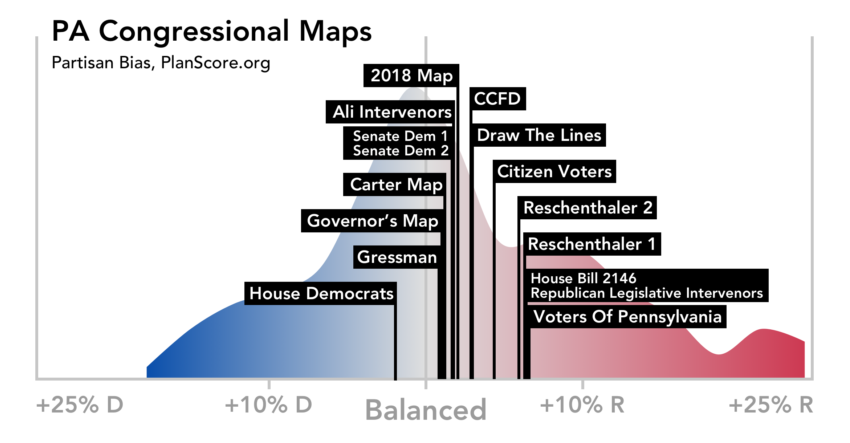Response to the Commonwealth Court Congressional District Recommendations
On Monday, February 7, Commonwealth Court Judge McCullough recommended adoption of House Bill 2146, the map proposed and amended by Representative Seth Grove and vetoed by Governor Wolf.
Our Summary
The PA Supreme Court has scheduled a hearing on February 18 to review Judge McCullough’s recommendation and make decisions on a final map. Parties to the case have until Monday, February 14, to submit responses to her recommendations.
Sometime before that the Supreme Court will also provide an adjusted primary calendar, which may keep the current primary date but adjust nomination petition deadlines, or move the primary to a later date.
McCullough’s reasoning relies heavily on testimony from the two most partisan witnesses to participate in the two days of hearing:
- The testimony of Dr. Michael Barber—a frequent GOP witness in redistricting litigation—was discredited by other experts for his lack of peer-reviewed work in the field, flaws in his analysis, and his conclusion that PA political geography “requires” a map with a strong pro-Republican bias.
- Dr. Keith Naughton’s testimony opined at length about PA communities of interest. When pressed for sources of such opinions, he admitted he had none other than his extensive work as a GOP campaign operative; no input from community organizations, no community outreach, no public polls or surveys.
McCullough’s lengthy recommendation raises important legal questions:
- When the legislative process excludes any input or support from the minority party, does the outcome “reflect and represent, on the whole, the will of the people”? p. 213, § 89
- Does a vetoed bill, without a vote to overturn that veto, provide “a profound depiction of what the voters in the Commonwealth of Pennsylvania desire”? p. 214, §93
- Should a bill passed with no minority support, vetoed by the governor, be considered, “functionally tantamount to the voice and will of the People, which, as a matter of American political theory since its founding, is a device of monumental import and should be honored and respected by all means necessary” p. 214, §94
- Should the process used to create that map be considered a full expression of public interest when a large share of public input expressed disapproval of the process, request for clarification of criteria, and outright opposition to the map in question?
- Is there any minimum standard for expert testimony? From what we’ve seen, both State Government Committees and Judge McCullough welcome less-than-credible testimony, giving weight to arguments in line with foregone conclusions.
The most important question will need clarification from the PA Supreme Court:
- Does a map drawn to minimize partisan bias provide “a partisan advantage to the Democratic party in contravention to the natural state of political voting behavior and bias towards Republicans in Pennsylvania”? This was the argument used to dismiss most of the maps that had least partisan bias.
According to Judge McCullough (p.197, §40):
[T]he Court finds that when lines are purposely drawn to negate a natural and undisputed Republican tilt that results from the objective, traditional, and historical practice whereby Democratic voters are clustered in dense and urban areas, such activity is tantamount to intentionally configuring lines to benefit one political party over another. The Court considers this to be a subspecies of unfair partisan gerrymandering and is legally obligated, pursuant to LWV II, to look up[on] such a practice with suspicious eyes.
Outside Analysis
Campaign Legal Center’s PlanScore Project provided us with a graphic to show the array of partisan bias in the proposed maps. According to an assessment that incorporates election results across the last decade, the bill proposed by Judge McCullough has the most Republican bias of any map submitted, and falls farthest from the balanced range in the gray center of the bell curve.

Compare Scores
We’ve pulled map links and metrics into two spreadsheets for comparison:
We look forward to clarification on this important question from the PA Supreme Court.